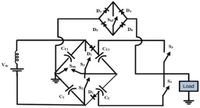In a significant advancement for power electronics, researchers have unveiled a new seven-level active neutral point clamped (ANPC) inverter that demonstrates remarkable efficiency and reduced harmonic distortion. This innovative design harnesses switched-capacitor technology, achieving a voltage boost of 1.5 while maintaining an impressive efficiency of 98.4%. This novel inverter configuration, which includes just six switches and six diodes, is tailored for renewable energy applications, showcasing its potential impact on the integration of solar and wind energy into existing power grids.
The new ANPC inverter is a product of a robust design that couples four capacitors with two bidirectional switches, resulting in fewer components compared to traditional models. This reduction not only simplifies the assembly and operational complexity but also enhances reliability, addressing a common challenge in power inverter designs.
One of the standout features of this inverter is its ability to produce a seven-level output voltage, with total harmonic distortion (THD) percentages of just 22.27% and 10.67% for voltage and current harmonics, respectively. These values mark a significant improvement in the inverter's performance, allowing it to operate more smoothly across various load conditions, particularly at 120W and 1.5 kW.
To optimize the inverter's efficiency further, the researchers have integrated a hybrid modulation technique that combines Level Shifted (LS) Pulse Width Modulation (PWM) with Phase Shifted (PS) PWM. This innovative approach lowers switching losses by leveraging the benefits of both modulation methods, ultimately enhancing the converter’s overall performance.
The importance of this research cannot be overstated, as efficient power conversion is integral to the advancement of renewable energy technologies and electric vehicles. With the ongoing global push for greener energy solutions, the development of highly efficient and compact inverters like this ANPC model will play a crucial role in facilitating the integration of renewable sources into the energy mix.
As the demand for renewable energy systems continues to rise, effective power electronic converters become vital. The proposed inverter stands out as it balances efficiency, compact design, and reduced complexity, suggesting its suitability for a wide range of applications, from energy storage systems to electric traction systems in vehicles.
In conclusion, this pioneering inverter design could revolutionize how renewable energy is harnessed and utilized, providing a reliable and efficient option for future electrical systems. The authors of the article assert that with its demonstrated high efficiency, low THD levels, and reduced charging currents, this seven-level inverter opens new doors for the deployment of clean energy technologies.

